Purchasing Setup
The Purchasing aspects of the Procurement hub include requisitions, purchase orders (POs), and received goods. The sections below outline the roles and permissions required, as well as a comparison table for users transitioning from the Desktop application.
Note
The following topics are specific to users transitioning from working in the Desktop to working in J1 Web. Resources for users transitioning to J1 Web Finance from the Campus Portal can be found here: Procurement for Campus Users.
Purchasing Settings
The settings to manage purchasing functionality are on the Procurement Settings page in the Procurement Administration hub. For more information about settings, see Procurement Settings.
Note
At this time, most of the purchasing configurations are still managed in the Desktop application from the Purchasing Module Setup window. Additional J1 Web functionality is scheduled for future releases.
Note
The notifications set up in the Desktop Purchasing Module Setup window are not honored in J1 Web.
Communications are delivered by email via the Communication Management feature when certain updates are made to POs and requisitions. The messages are defined in interactions, which are managed on the Interactions page.
Automation plans send the interactions when an event happens in J1. There's an equivalent automation plan for each of the interactions provided by default. They're managed on the Automation Plan page.
If you want to make changes to the default templates, Jenzabar recommends creating a copy of the default interactions and automation plans, and then making the default interactions/automation plans inactive.
Permissions Required
To manage the Procurement interaction templates and automation plans, you must be in a Communication Management Base role with the following permissions:
Can add or edit interactions
Can add or edit automation plans
Additionally, you must have Module Access enabled for Purchasing. This is typically enabled in a Procurement - Purchasing role.
Note
For more detailed information about working with interactions and automation plans, see Manage Interactions and Automation Plans.
On the Communication Management hub, click Hub options and select Interactions. The Interactions page opens.
Make a copy of each of the default purchase order interactions, and make the defaults inactive.
In the filter, select the Keyword checkbox, type one of the Codes from the table below, and click Apply. The interaction appears.
In the Status column, click the Active button to change it to Inactive.
In the Actions drop-down, select Copy. The Copy Interaction wizard page opens to the Basics settings.
Type: Email is the default for recipients.
Name / Description and Code: Use the information in the table below as a guide for your Name / Description and Code. Give the copy the same Code as the default it's copied from. You can use the same Default Name / Description, or modify it to your liking.
The prepopulated values for the rest of the Basics page are probably correct, but some are editable. Review them and click Save and continue.
Warning
Don't select Do not allow duplicate interactions for a record. Leave it unselected.
Tip
The Show in Communication Feed checkbox is available for schools that have the Communication Management Plus license.
The Data Merge Options are preselected. Make sure they're okay, and click Save and continue.
The Email Basics options are preselected. Make sure they're okay, and click Save and continue.
The Template Content options:
Click the Status button to change it to Active.
Check the Content section and edit as necessary.
Click Save and finish. The copied interaction now appears in the list.
Tip
If you haven't changed the filter settings, just click Apply again. The default and the copy appear.
Repeat these steps for each of the purchase order interactions.
Tip
If you included "Purchase Order" in each Name / Description field, then you can find all the purchase order interactions by filtering for "Purchase Order" in either Keyword or Name / Description.
On the Communication Management hub, click Hub options and select Interactions. The Interactions page opens.
Make a copy of each of the default requisition interactions and make the defaults inactive.
In the filter, select the Keyword checkbox, type one of the Codes from the table below, and click Apply. The interaction appears.
In the Status column, click the Active button to change it to Inactive.
In the Actions drop-down, select Copy. The Copy Interaction wizard page opens to the Basics settings.
Type: Email is the default for recipients.
Name / Description and Code: Use the information in the table below as a guide for your Name / Description and Code. Give the copy the same Code as the default it's copied from. You can use the same Default Name / Description, or modify it to your liking.
The prepopulated values for the rest of the Basics page are probably correct, but some are editable. Review them and click Save and continue.
Warning
Don't select Do not allow duplicate interactions for a record. Leave it unselected.
Tip
The Show in Communication Feed checkbox is available for schools that have the Communication Management Plus license.
The Data Merge Options are preselected. Make sure they're okay and click Save and continue.
The Email Basics options are preselected. Make sure they're okay and click Save and continue.
The Template Content options:
Click the Status button to change it to Active.
Check the Content and edit as necessary.
Click Save and finish. The copied interaction now appears in the list.
Tip
If you haven't changed the filter settings, just click Apply again. The default and the copy appear.
Repeat these steps for each of the requisition interactions.
Tip
If you included "Requisition" in each Name / Description field, then you can find all the requisition interactions by filtering for "Requisition" in either Keyword or Name / Description.
On the Communication Management hub, click Hub options, and select Automation Plans. The Automation Plans page opens.
Make a copy of each of the default purchase order automation plans. Default plans are noted with an asterisk (*) next to the Code.
In the filter, select the Keyword checkbox, type one of the Codes listed below, and click Apply. The automation plan appears.
In the Status column, click the Active button to change it to Inactive.
In the Actions drop-down, select Copy. The Copy pop-up opens to the Basics page.
Name / Description and Code: Use the information in the table below as a guide for your Name / Description and Code. Give the copy the same Code as the default it's copied from. You can use the same Default Name / Description, or modify it to your liking.
Initiated By: Keep the default, System Event. The system event is, for example, a change to a PO.
Module, Process, and Event are prepopulated from the default automation plan.
Click Save and continue. The Automation Tasks page opens.
On the Automation Tasks page, the Interactions radio button is selected. Change the associated interaction from the default to the corresponding copy:
In Interaction Name / Description, begin typing the name of the copied interaction that corresponds with this automation plan. Select the interaction from the list.
Click Add to plan. The interaction appears in the Tasks list below.
On the row for the default interaction, click the Remove icon
 . The default interaction is removed from the list.
. The default interaction is removed from the list.
Click Save and continue. The Recipients page opens.
On the Recipients page, click the Inactive button to make it Active.
The Recipients options are preselected. Make sure the radio button for Anyone associated with system event is selected.
Click Save and finish. The copied automation plan now appears in the list.
Tip
If you haven't changed the filter settings, just click Apply again. The default and the copy appear.
Repeat these steps for each of the purchase order automation plans.
Tip
If you included "Purchase Order" in each Name / Description field, then you can find all the purchase order automation plans by filtering for "Purchase Order" in either Keyword or Name / Description.
On the Communication Management hub, click Hub options, and select Automation Plans. The Automation Plans page opens.
Make a copy of each of the default requisition automation plans. Default plans are noted with an asterisk (*) next to the Code.
In the filter, select the Keyword checkbox, type one of the Codes listed below, and click Apply. The automation plan appears.
In the Status column, click the Active button to change it to Inactive.
In the Actions drop-down, select Copy. The Copy pop-up opens to the Basics page.
Name / Description and Code: Use the information in the table below as a guide for your Name / Description and Code. Give the copy the same Code as the default it's copied from. You can use the same Default Name / Description, or modify it to your liking.
Initiated By: Keep the default, System Event. The system event is, for example, a requisition was approved.
Module, Process, and Event are prepopulated from the default automation plan.
Click Save and continue. The Automation Tasks page opens.
On the Automation Tasks page, the Interactions radio button is selected. Change the associated interaction from the default to the corresponding copy:
In Interaction Name / Description, begin typing the name of the copied interaction that corresponds with this automation plan. Select the interaction from the list.
Click Add to plan. The interaction appears in the Tasks list below.
On the row for the default interaction, click the Remove icon
 . The default interaction is removed from the list.
. The default interaction is removed from the list.
Click Save and continue. The Recipients page opens.
On the Recipients page, click the Inactive button to make it Active.
The Recipients options are preselected. Make sure the radio button for Anyone associated with system event is selected.
Click Save and finish. The copied automation plan now appears in the list.
Tip
If you haven't changed the filter settings, just click Apply again. The default and the copy appear.
Repeat these steps for each of the requisition automation plans.
Tip
If you included "Requisition" in each Name / Description field, then you can find all the requisition automation plans by filtering for "Requisition" in either Keyword or Name / Description.
To receive emails from J1 Web, users need to have a valid email address associated with their profile. They do not need to be in a Communication Base role.
If you aren't making any changes to the default emails, you do not need to create copies. You can continue using the Jenzabar-provided interactions and automation plans.
Requisitions
Access to work with requisitions in J1 Web is managed by roles and permissions. To view pages and make updates to information in the system, users must be in the appropriate roles (similar to a Group ID in Desktop) with permissions enabled. The following roles and permissions are needed for admins who work with requisitions.
Note
The roles and permissions listed below are the recommended roles for admins who work with requisitions. Your school may have additional (or fewer) roles and permissions assigned to people who work with requisitions.
Procurement - Purchasing Role
The default Procurement - Purchasing role provides the following permissions to work with requisitions. Administrators and module managers can grant users some or all of these permissions based on their daily responsibilities.
Tip
Jenzabar recommends creating copies of the default role to manage user permissions at your school. Depending on your school's processes, you may have various copies of a role that grant different sets of users certain permissions to work with requisitions.
Permission | Users in this role can . . . |
|---|---|
All requisitions | Perform actions granted by other permissions for all requisitions in the system. This option is deselected by default. When it is deselected, users are able to view and perform actions only on requisitions that they've submitted or are associated with as a requester, purchasing agent, or approver. |
Can view requisitions and generate reports | Access the requisitions list, view requisition details, read and add comments, and create reports for selected requisitions. |
Can edit requisitions | Update requisition details and add or remove line items. |
Can create requisitions | Create new requisitions from the requisitions list or from the requisition details page. |
Can download to Excel | Download individual or multiple requisitions from the list page, and download line items from a specific requisition's detail page. |
Can copy requisitions | Create duplicate requisitions from existing requisitions. |
Can delete requisitions | Delete requisitions from the system on the requisitions list page or on the requisition details page. |
Can unlock requisitions | Unlock requisitions that are in use by others in the system. During the unlock process, any unsaved changes made by the other user or the user unlocking the requisition are lost. |
Can approve, deny, return requisitions | Review submitted requisitions and approve, deny, or return them to the submitter. NoteTo perform these actions, users must be listed as the next approver in the approval track associated with the requisition. Approval tracks are set up and managed in Desktop from the Purchasing Module Setup window > Approvals tab. |
General Ledger Accounting Roles
Requisition line items are associated with GL accounts and can also be associated with project codes. To view GL account information and access project codes on requisition pages, users must be in one or more of the following General Ledger Accounting Hub roles (or roles copied from these roles) with the noted permissions.
General Ledger Accounting GL Account Component Access role, with "Can view all GL accounts (unrestricted)" permission
General Ledger Accounting GL Account Alternate Code Access role, with "Can view all GL accounts (unrestricted)" permission
General Ledger Accounting Project Access role, with "Can view all projects (unrestricted)" permission
Note
To restrict user access to one or a few accounts or project codes, enable those specific codes on the Associations tab and select "Can view only GL accounts/projects enabled by associations (restricted)" on the Permissions tab.
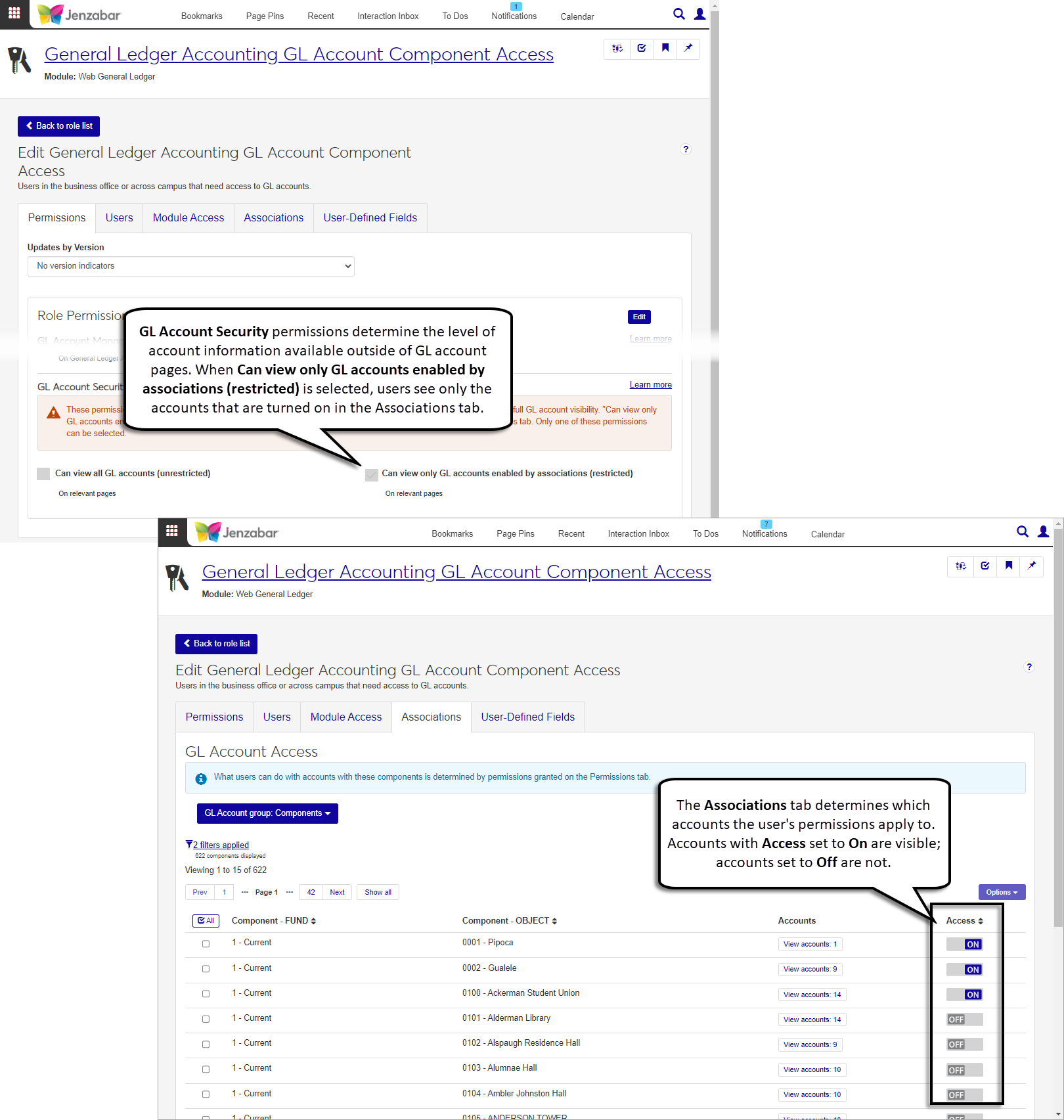
Common Roles
In addition to the functionality in the Procurement hub, users who work with requisitions may also need access to view, update, or add person and organization information. To perform these actions, they'll need to be in one or more of the roles outlined below.
Role | Permissions |
|---|---|
Person Management |
|
Organization Management |
|
External Person Management |
|
External Organization Management |
|
Communication Management Base |
|
The table below lists the Desktop window and the corresponding J1 Web page where that functionality is available. Requisitions can be accessed in the Finance, Procurement hub.
Desktop Window | J1 Web Page |
|---|---|
Create Requisition | Create Requisition 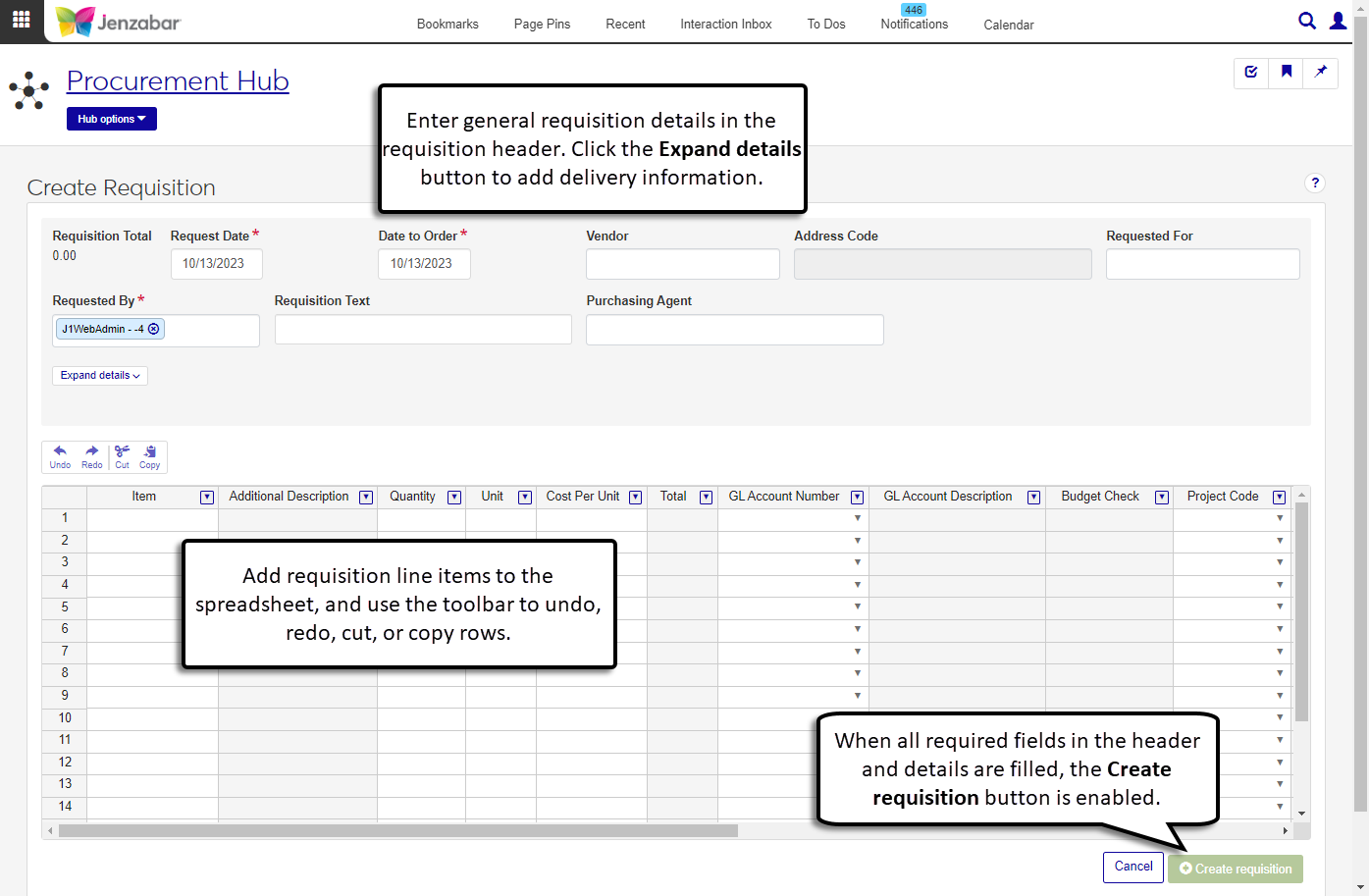 |
Check Requisition Status | Requisition List 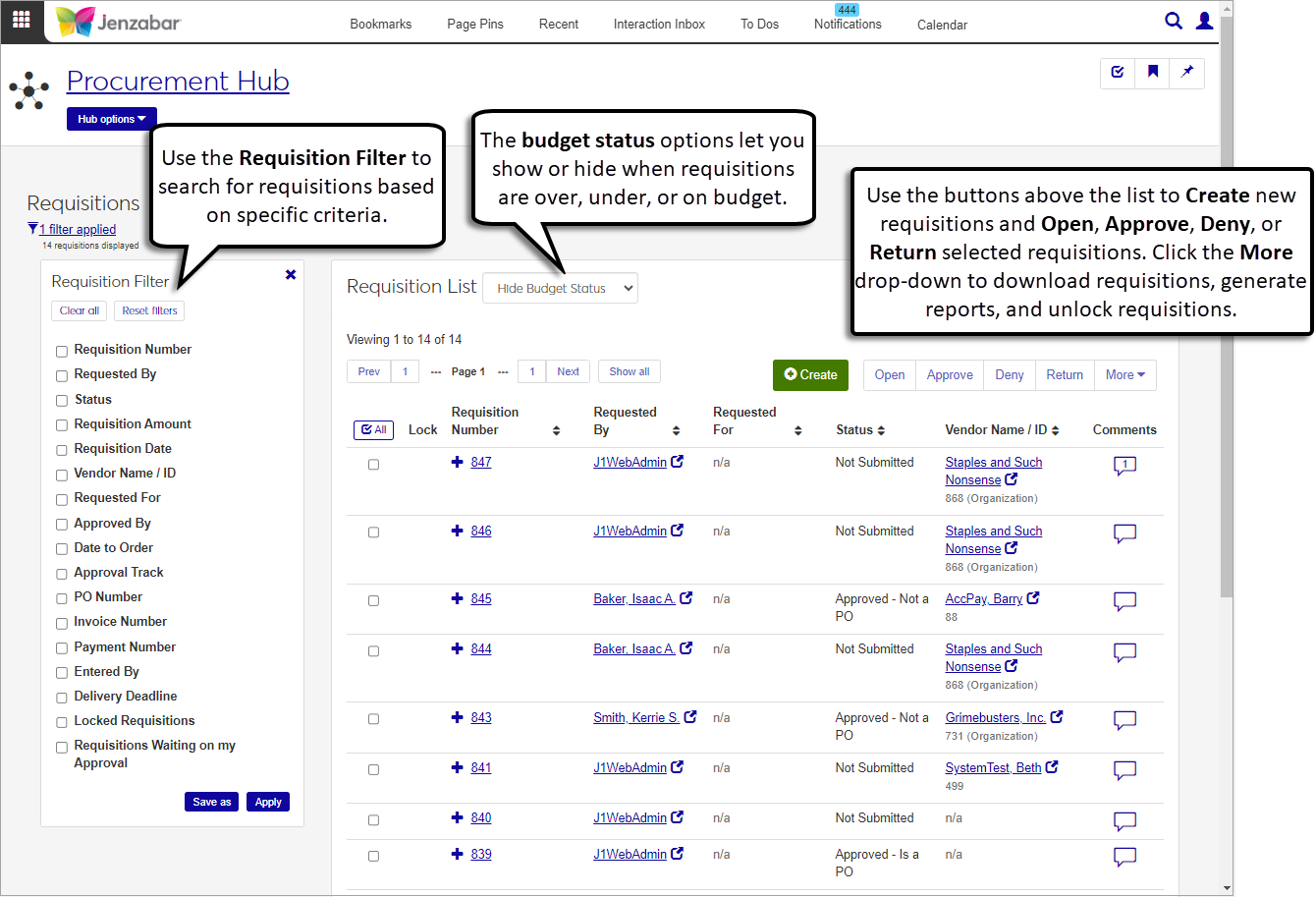 |
Edit Requisition | Requisition Header and Details 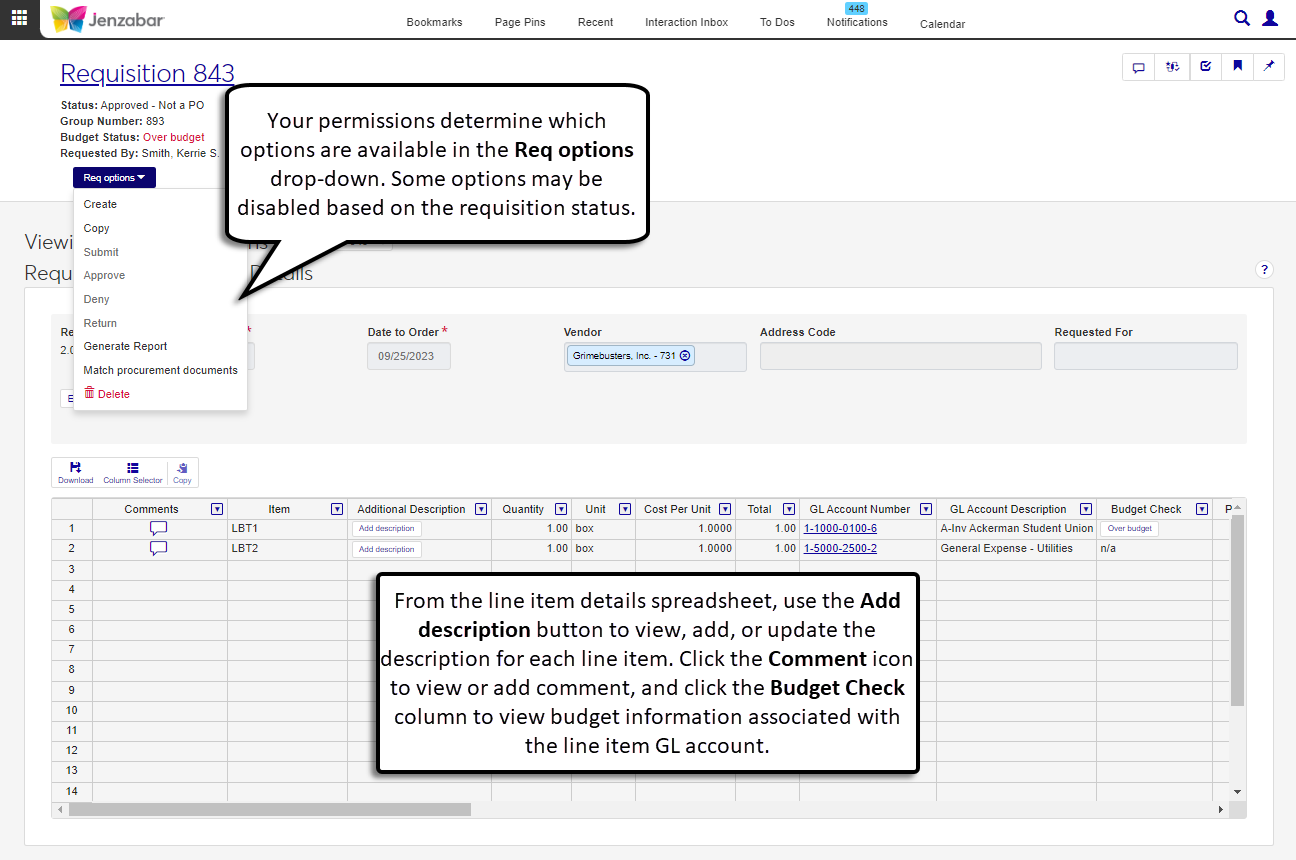 |
Approve Requisitions | Requisitions List > Select rows > Approve, Deny, and Return buttons 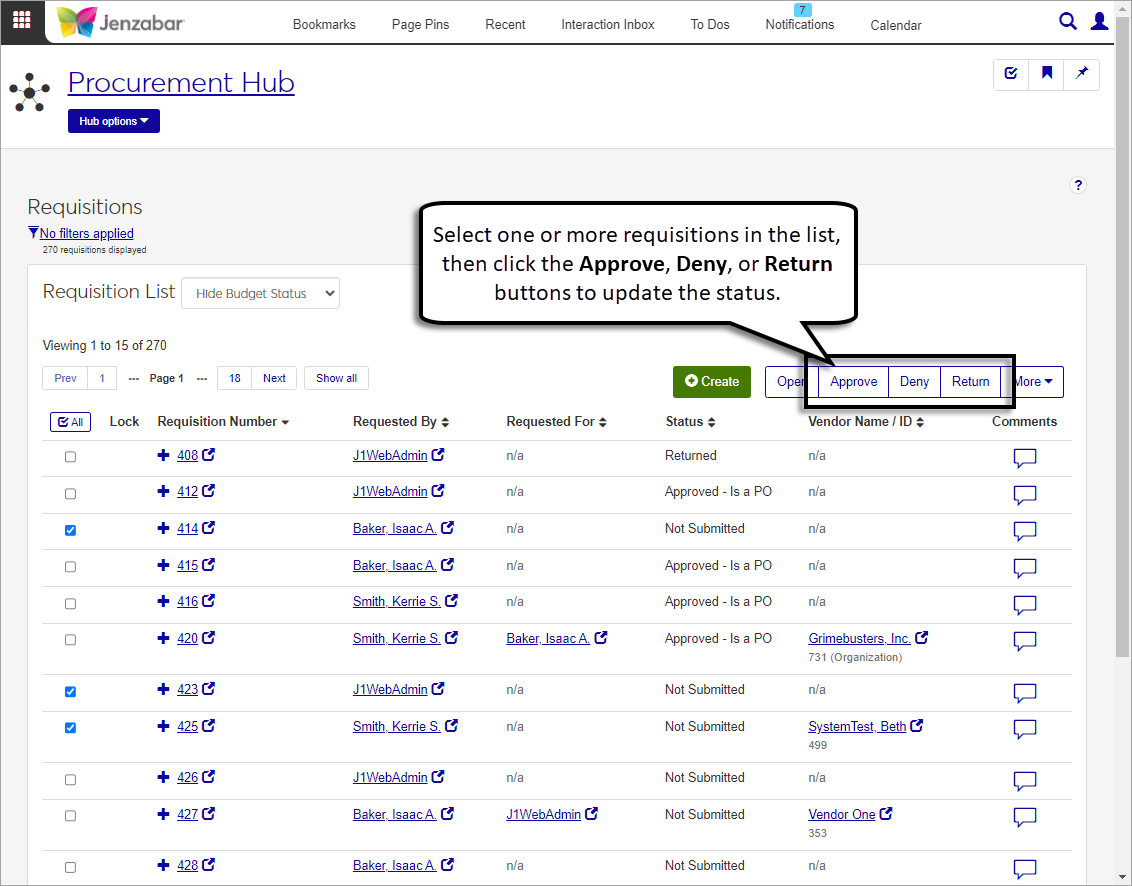 |
Match Requisition, PO, Invoice and Check | Requisition Details > Req options drop-down, Match procurement documents  |
Purchase Orders
Access to work with purchase orders in J1 Web is managed by roles and permissions. To view pages and make updates to information in the system, users must be in the appropriate roles (similar to a Group ID in Desktop) with permissions enabled. The following roles and permissions are needed for admins who work with purchase orders.
Note
The roles and permissions listed below are the recommended roles for admins who work with POs. Your school may have additional (or fewer) roles and permissions assigned to people who work with POs.
There are separate recommendations for campus users who work with purchase orders. For more information about permissions for those users, see Procurement for Campus Users.
Procurement - Purchasing Role
The default Procurement - Purchasing role provides the following permissions to work with POs. Administrators and module managers can grant users some or all of these permissions based on their daily responsibilities.
Tip
Jenzabar recommends creating copies of the default role to manage user permissions at your school. Depending on your school's processes, you may have various copies of a role that grant different sets of users certain permissions to work with POs.
Permission | Users in this role can . . . |
|---|---|
All purchase orders | Perform actions granted by other permissions for all purchase orders (POs) in the system. This option is deselected by default. When it is deselected, users are able to view and perform actions only on POs that they've submitted or are associated with (e.g., they are an alternate requester for the PO). |
Can view purchase orders and generate reports | Access the PO list, view PO details, read and add comments, and create PDF reports for selected POs. |
Can edit purchase orders | Update PO details and add or remove line items. |
Can create purchase orders | Create new purchase orders from the PO list or from the PO details page. |
Can download to Excel | Download individual or multiple POs from the list page, and download line items from a specific PO's detail page. |
Can delete purchase orders | Delete POs from the system on the PO list page or from the PO details page. |
Can unencumber purchase orders | Remove encumbrances from POs. |
Can unlock purchase orders | Unlock POs that are in use by others in the system. During the unlock process, any unsaved changes made by the other user or the user unlocking the PO are lost. |
Can copy purchase orders | Create duplicate POs from existing POs. |
Can copy requisition to purchase orders | NoteThis option is available when the requisition approval isn't set to automatically create a PO (Desktop Purchasing Module Setup window > Approvals tab > Upon final approval setting must be "Don't Create a PO"). Create purchase orders from approved requisitions. |
Can create Open Purchase Orders Not Invoiced report | Generate the Open Purchase Orders Not Invoiced report. |
Can create Open Purchase Orders Not Received reports | Generate the Open Purchase Orders Not Received report. |
Can create Purchase Orders By Vendor reports | Generate the Purchase Orders by Vendor report. |
Can create Purchase Orders By Date Printed reports | Generate the Purchase Orders by Date Printed report. |
Can create MSDS reports | Generate the MSDS report. |
General Ledger Accounting Roles
PO line items are associated with GL accounts and can also be associated with project codes. To view GL account information and access project codes on purchase order pages, users must be in one or more of the following General Ledger Accounting Hub roles (or roles copied from these roles) with the noted permissions.
General Ledger Accounting GL Account Component Access role, with "Can view all GL accounts (unrestricted)" permission
General Ledger Accounting GL Account Alternate Code Access role, with "Can view all GL accounts (unrestricted)" permission
General Ledger Accounting Project Access role, with "Can view all projects (unrestricted)" permission
GL accounts must also be designated as "Available for purchasing" to appear in drop-downs on PO pages.
Note
The permissions outlined above assume that users entering POs should be able to select from all GL accounts and project codes designated for purchasing in your system. If you need to restrict user access to one or a few accounts or project codes, you'll need to enable those specific codes on the Associations tab and select "Can view only GL accounts/projects enabled by associations (restricted)" on the Permissions tab.

Common Roles
In addition to the functionality in the Procurement hub, users who work with POs may also need access to view, update, or add person and organization information. To perform these actions, they'll need to be in one or more of the roles outlined below.
Role | Permissions |
|---|---|
Person Management |
|
Organization Management |
|
External Person Management |
|
External Organization Management |
|
Communication Management Base |
|
The table below lists the Desktop window and the corresponding J1 Web page where that functionality is available. Purchase orders can be accessed in the Finance, Procurement hub.
Desktop Window | J1 Web Page |
|---|---|
Create Purchase Orders from Requisitions | Copy Requisitions to Purchase Orders 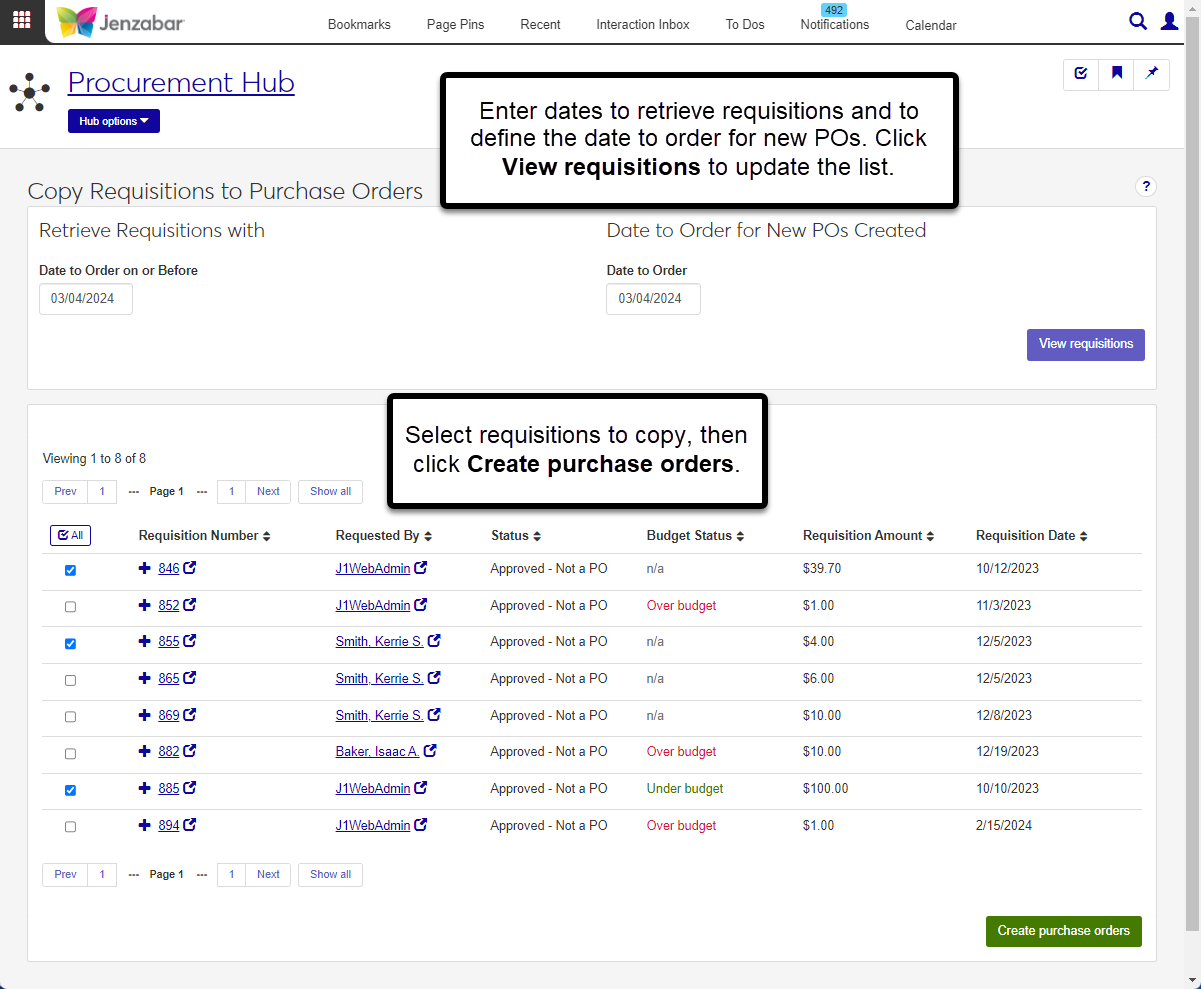 |
Create/Edit Purchase Orders (create new) | Create Purchase Order 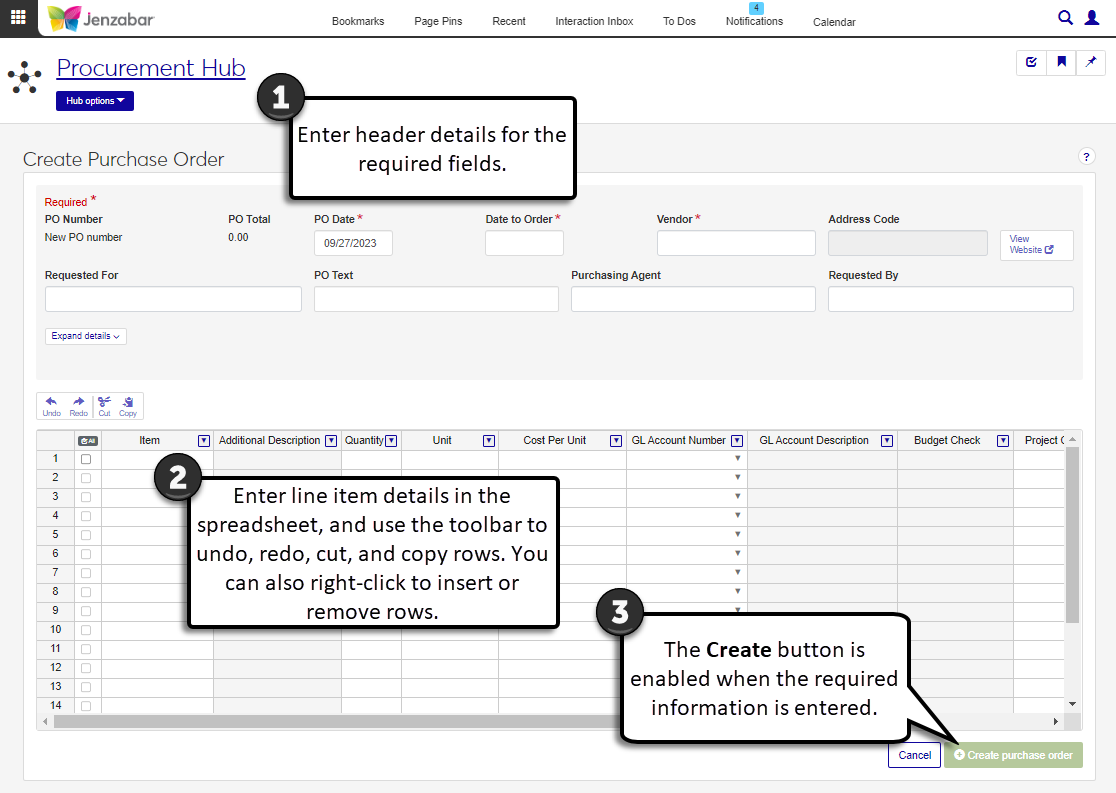 |
Create/Edit Purchase Orders (edit existing) | Purchase Order Header and Details 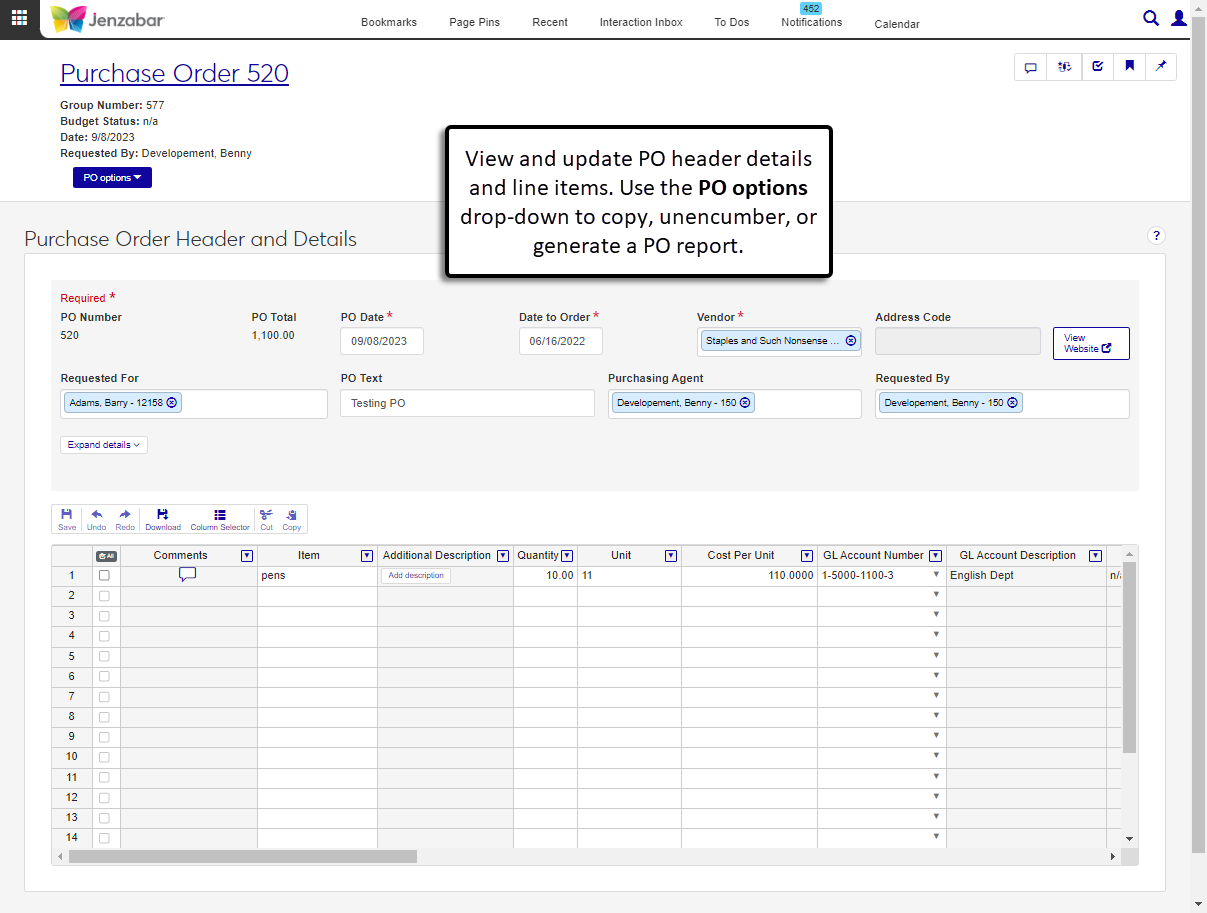 |
Print or Email a PO (print the PO file) | Purchase Orders List page > Select POs > More drop-down, Generate report 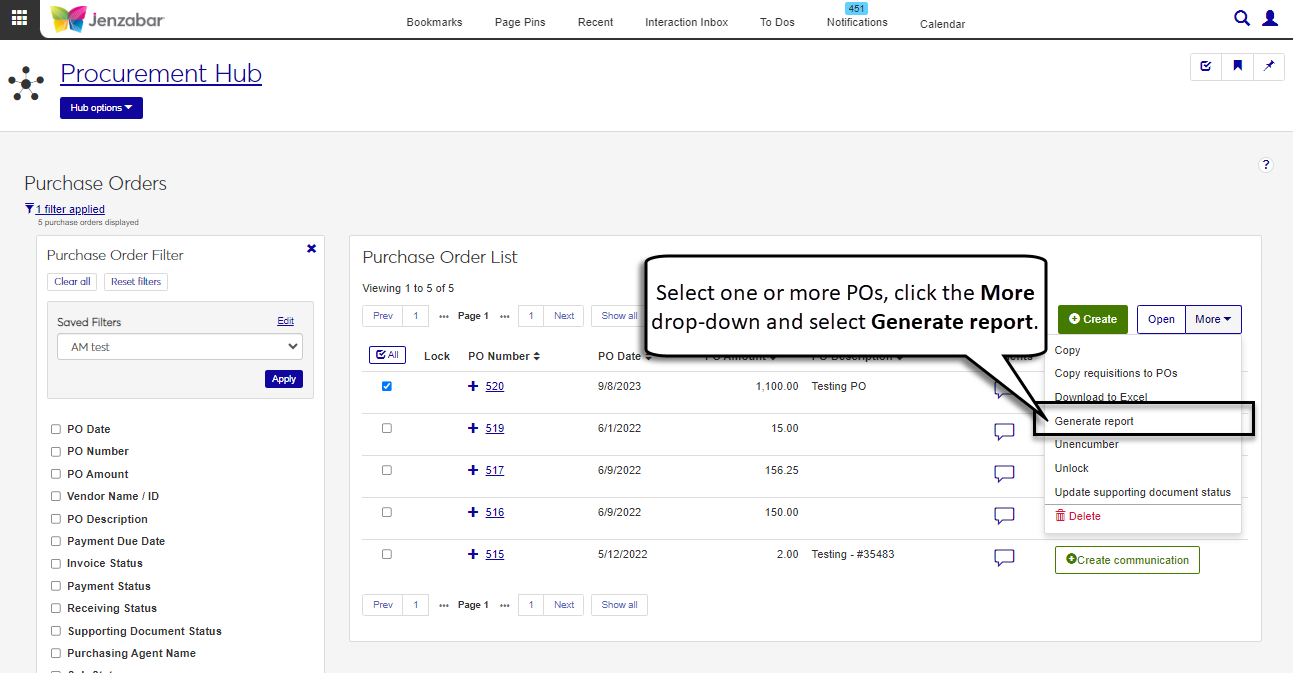 Purchase Order Header and Details page > PO options > Generate report 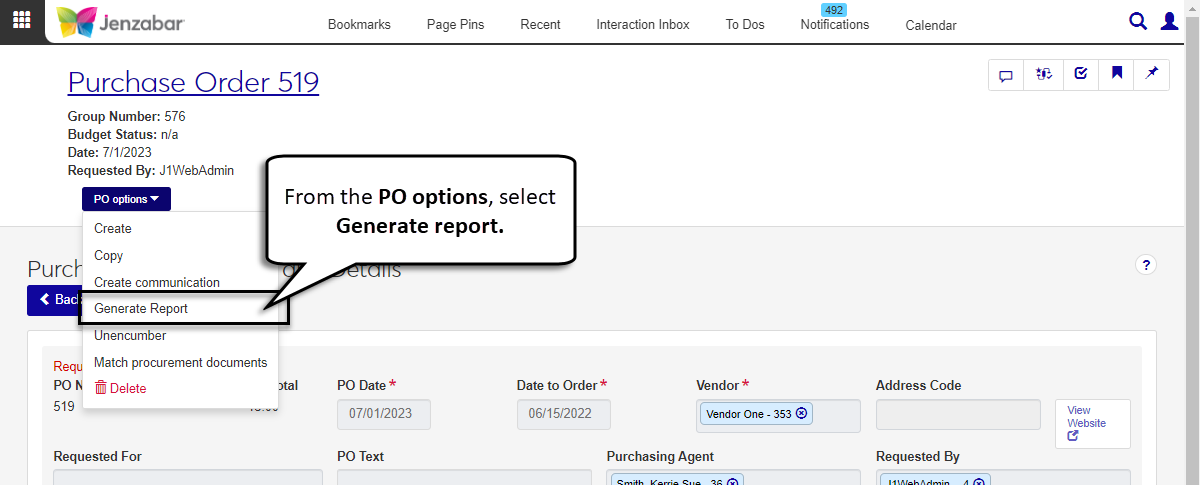 |
Print or Email a PO (email the PO file) | Purchase Order List > Create communication 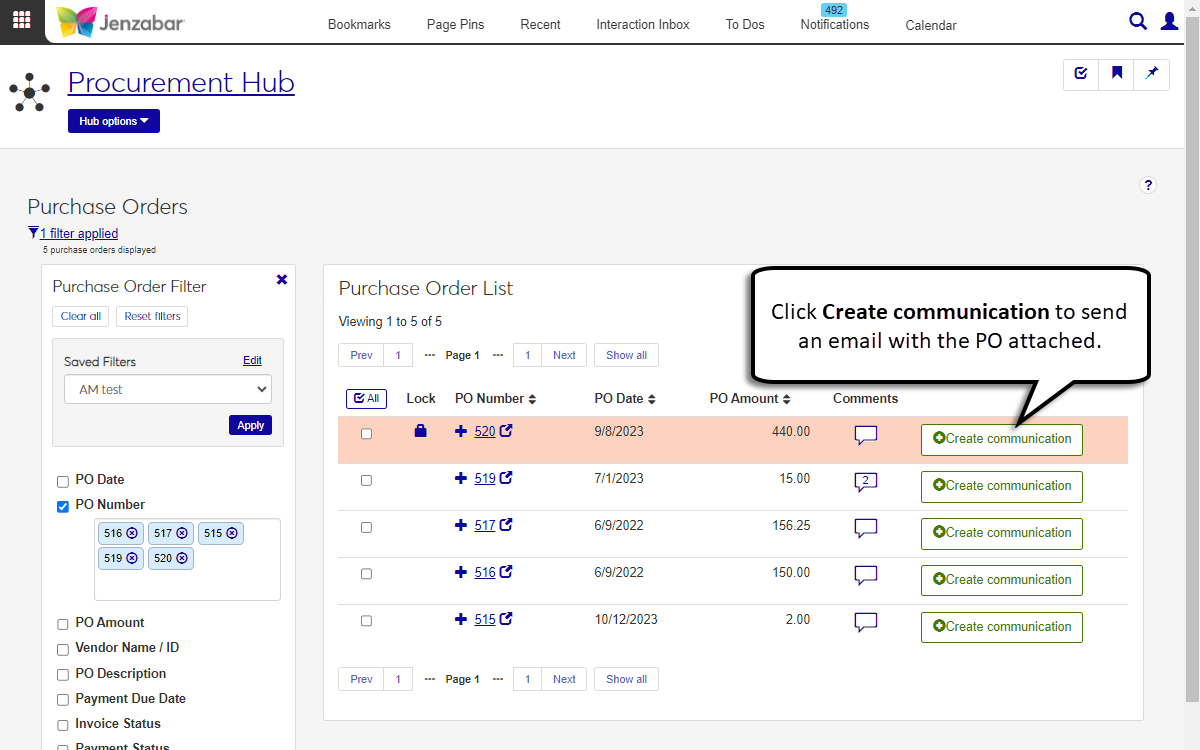 Purchase Order Header and Details > PO options > Create communication 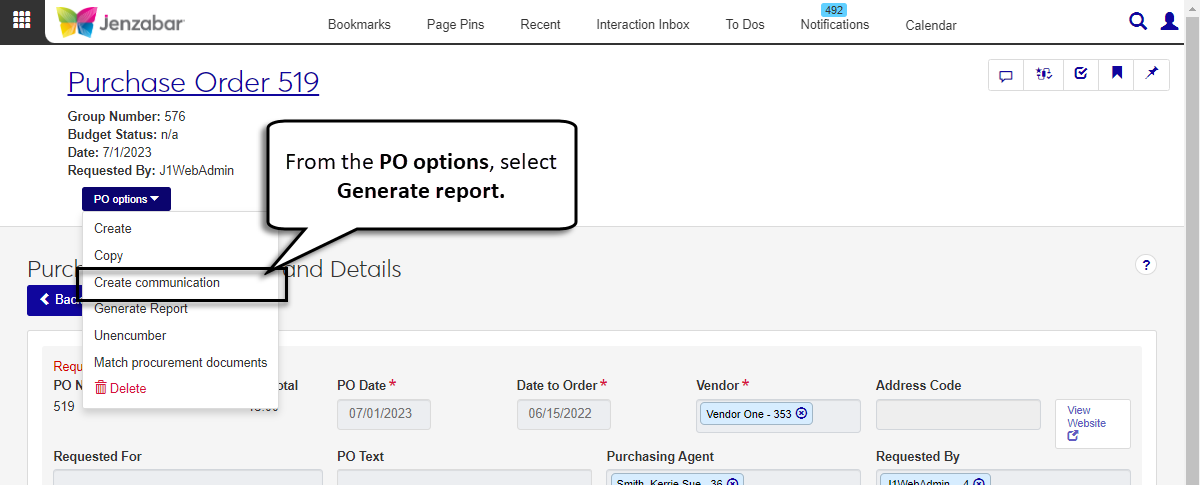 |
Lookup Previously Created PO | Purchase Order List  |
Purchase Order Search and Status | Purchase Order List > Select POs and click Open 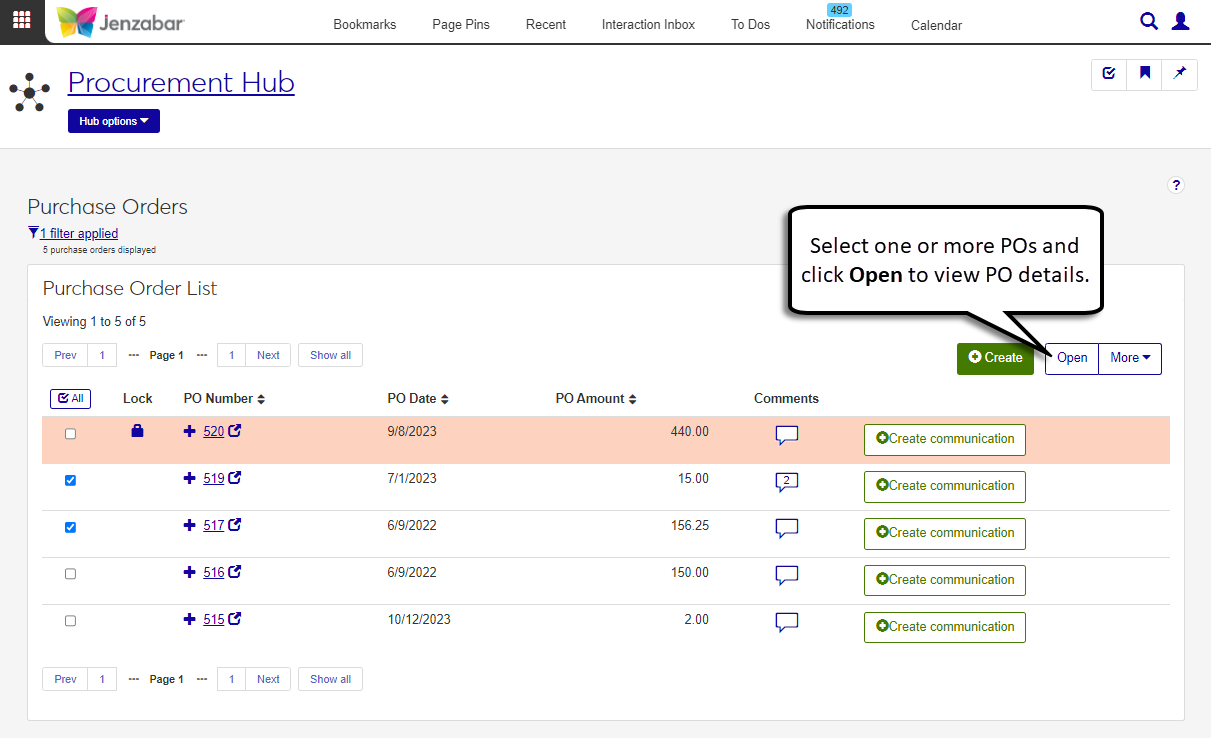 |
Unencumber Purchase Orders | Purchase Order List > Select POs > More drop-down and select Unencumber  Purchase Order Header and Details > PO options drop-down and select Unencumber 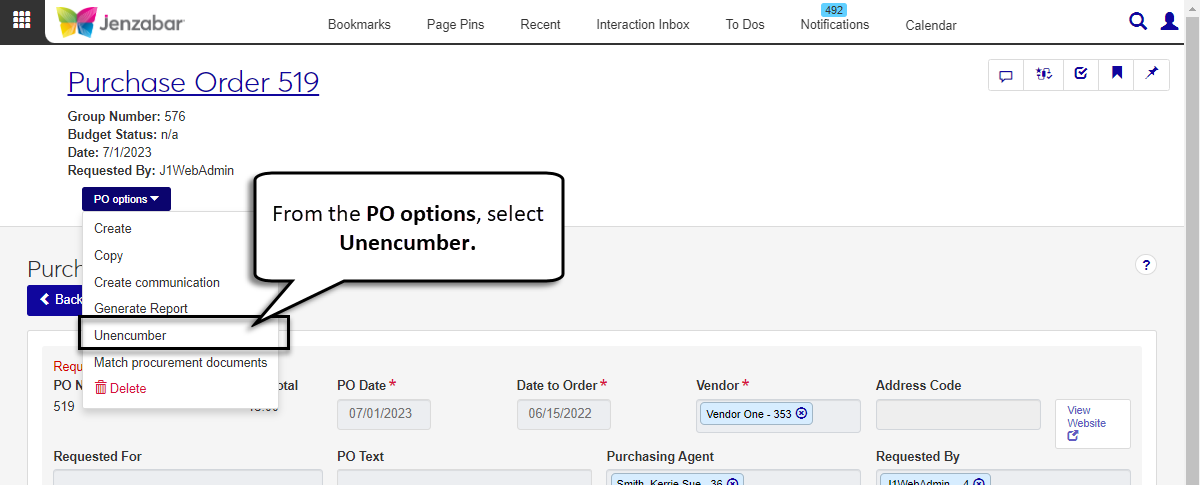 |
Match Requisition, PO, Invoice and Check | Purchase Order Header and Details > PO options drop-down, Match procurement documents 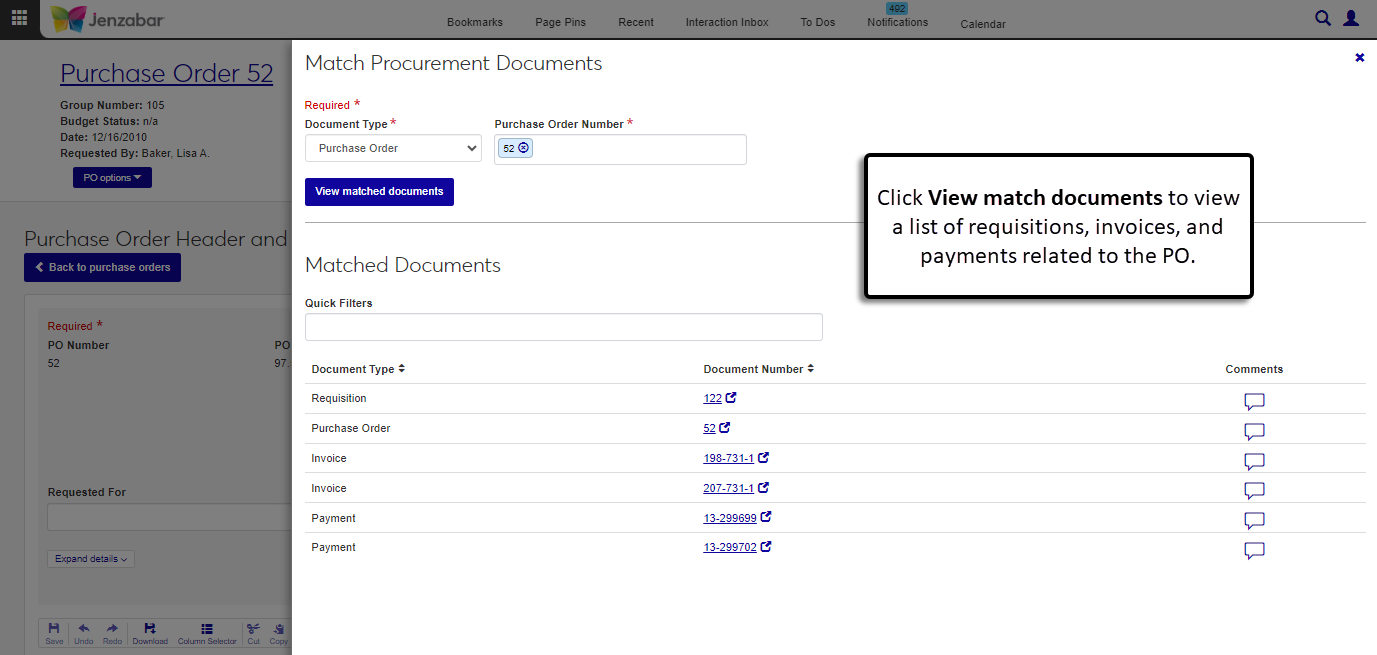 |
Receive Goods
To receive goods, users must have permissions to work with POs and permission to view and edit receive goods. No additional setup is needed in J1 Web at this time.
Example Role Setup for Procurement - Purchasing Users
Below are some example roles and permissions for users in typical finance positions. Jenzabar recommends copying the default roles and assigning users to the copied roles. In the examples below, the role naming convention for copied roles is "[Position Code] - [Default role name]". It's recommended that you develop a naming convention for copied roles, as there will likely be several copies of each role in your system.
 | Becky is an executive assistant for the School of Business and serves as their purchasing clerk. She is in a Purchasing Clerk position associated with the following roles. |
The following roles and permissions let Becky view and manage general information about people and organizations.
Note
Module Access doesn't need to be turned on for any of the Common roles.
Role | Permissions |
|---|---|
POCLRKBUS - Person Management |
|
POCLRKBUS - Organization Management |
|
POCLRKBUS - External Person Management |
|
POCLRKBUS - External Organization Management |
|
POCLRKBUS - Communication Management Base |
|
The following roles and permissions let Becky view GL account and project information for the procurement documents she manages. In addition to the roles and permissions noted below, GL accounts must be designated as "Available for purchasing" to appear in drop-downs on procurement pages.
Note
Module Access should be turned on for the GENERALLEDGER code for at least one of the roles below.
Role | Permissions | Associations |
|---|---|---|
POCLRKBUS - General Ledger Accounting GL Account Alternate Code Access |
| Access turned on for alternate security codes related to School of Business accounts |
POCLRKBUS - General Ledger Accounting GL Account Component Access |
| Access turned on for account component combinations used by the School of Business |
POCLRKBUS - General Ledger Accounting Project Access |
| Access turned on for project codes associated with the School of Business |
The following roles and permissions let Becky view and work with invoices, requisitions, purchase orders (POs), and payments.
Role | Permissions | Module Access |
|---|---|---|
POCLRKBUS - Procurement - Accounts Payable |
| Access turned on for the ACCOUNTSPAYABLE code |
POCLRKBUS - Procurement - Purchasing |
NoteBoth the "All requisitions" and "All purchase orders" permissions must be selected so Becky can view requisitions and POs without restriction. | Access turned on for the PURCHASING code |
 | Janet is the Department Head for the School of Business. She's in a Purchasing Manager position with the following roles and permissions. |
The following roles and permissions let Janet view and manage general information about people and organizations.
Note
Module Access doesn't need to be turned on for any of the Common roles.
Role | Permissions |
|---|---|
POMGRBUS - Person Management |
|
POMGRBUS - Organization Management |
|
POMGRBUS - External Person Management |
|
POMGRBUS - External Organization Management |
|
POMGRBUS - Communication Management Base |
|
POMGRBUS - Documents and Attachments | Can manage attachment/file configurations |
The following roles and permissions let Janet view GL account and project information for the procurement documents she manages. In addition to the roles and permissions noted below, GL accounts must be designated as "Available for purchasing" to appear in drop-downs on procurement pages.
Note
Module Access should be turned on for the GENERALLEDGER code for at least one of the roles below.
Role | Permissions | Associations |
|---|---|---|
POMGRBUS - General Ledger Accounting GL Account Alternate Code Access |
| Access turned on for alternate security codes related to School of Business accounts |
POMGRBUS - General Ledger Accounting GL Account Component Access |
| Access turned on for account component combinations used by the School of Business |
POMGRBUS - General Ledger Accounting Project Access |
| Access turned on for project codes associated with the School of Business |
POMGRBUS - General Ledger Accounting GL Transaction Access | Can view and download GL transactions | n/a |
The following roles and permissions let Janet view and work with invoices, requisitions, purchase orders (POs), and payments.
Role | Permissions | Module Access |
|---|---|---|
POMGRBUS - Procurement - Accounts Payable |
| Access turned on for the ACCOUNTSPAYABLE code |
POMGRBUS - Procurement - Purchasing | All permissions in the Requisitions, Purchase Orders, and Receive Goods sections NoteBoth the "All requisitions" and "All purchase orders" permissions must be selected so Janet can view requisitions and POs without restriction. | Access turned on for the PURCHASING code |
POMGRBUS - Purchasing User and Role Management |
| Access turned on for the PURCHASING code |
POMGRBUS - Procurement Administration | All permissions | n/a |
Additional Resources
Tip
These resources and more are available on the MyJenzabar Procurement Resource Center.
J1 Web Finance Permissions Overview and Setup Guide
Working with Requisitions in J1 Web Transition Guide
Working with Purchase Orders in J1 Web Admin Guide
Working with Orders and Requisitions in J1 Web Transition Guide
